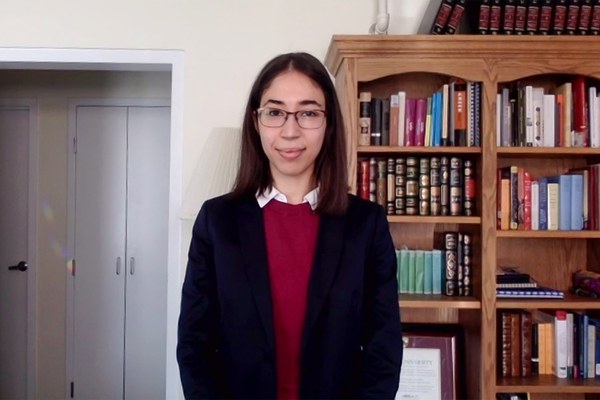Hannelore Segers, PhD candidate in classical philology at Harvard University, is a Tyler fellow in Byzantine Studies. Her research report, “Paraphrasis and Cento: A Comparative Analysis of Late Antique Greek and Latin Versification,” outlined the confluence of classical antiquity and Christianity in late antique poetry.
Q&A with Hannelore Segers
What are the two genres of poetry you study (paraphrasis and cento)?
Paraphrasis was originally a school exercise in classical antiquity where young students were asked to rewrite a passage from a text by a famous author using their own words. It’s similar to what students today do when they “paraphrase”—the student interprets the sense of a text and rewrites it in different words. The type of paraphrasis I’m studying, though, was a very specific type where the author adapted the content of the Bible into epic poetry.
Late antique cento was similar to paraphrasis; you could even call it a kind of paraphrasis since the author was also adapting biblical stories into forms of poetry. But instead of using his or her own words, the poet used phrases and sentences of other famous poets. Cento is the Latin word for “patchwork,” because the poet was piecing together phrases and sentences from other authors to create an original literary piece. In the case of the texts I’m studying, the poets being emulated were the two most influential and prominent epic poets of antiquity, Virgil and Homer.
How do these genres appear in your project?
I study how these genres were perceived in late antiquity and how the literary and religious atmosphere of the time influenced their evolution. Late antiquity was characterized by a variety of sociopolitical, religious, linguistic, and economic changes like the invasions by the barbarians and the formal acceptance of Christianity as the state religion in the Roman Empire. At the same time, many traditions of classical antiquity remained and continued to exert influence, like these poetic genres in the educational realm. Cento and paraphrasis had existed since classical antiquity, but they were also very much characteristic of the late antique zeitgeist in seeking to marry the traditions of classical antiquity with the new religious realities and demands of late antiquity.
Authors of centonic and paraphrastic works integrated traditional verse, exemplified by Homer in Greek and Virgil in Latin, with new biblical stories. I am studying how these versifications arose in late antiquity, who was the targeted audience, and who actually read them. Many of the biblical paraphrases and centos in Latin have introductory passages where the authors write letters to an imaginary audience explaining what they were trying to accomplish with their work. These letters suggest many authors were trying to educate their audience in both content and form—simultaneously demonstrating what a good epic looks like and teaching the meaning of stories of the Bible. Finally, I also study how authors assimilated traditional epic characters with biblical stories. For example, characters like Aeneas in Virgil and Achilles in Homer were integrated with biblical characters everyone would have been familiar with, like Christ.
What does your comparative study of Latin and Greek texts add to our understanding of late antiquity?
Scholars of late antiquity usually study across multiple languages and cover a wide geographic range, so the period lends itself well to comparative analyses. I am, for example, comparing the Cento Vergilianus of Faltonia Betitia Proba and the Homerocentones of Aelia Eudocia. Proba was a Latin-speaking Christian poet at the end of the fourth century, and Eudocia, about a generation later, was the Greek-speaking Roman Empress. I’m looking not only at how they employed the same genres, but also how they had similar opinions about content and how they brought together the demands of the classical tradition and late antiquity.
It’s interesting to see the responses to two female aristocratic authors in their own periods and later on. Proba seemed to have had a relatively widespread popularity but a mixed reception: she was praised by some later authors but is also implicated in criticism from church fathers like Jerome, who didn’t believe there was nor should be a relationship between Virgil and Christ. I also work with the Dumbarton Oaks Medieval Library, and [DOML Managing Editor] Nicole Eddy has asked me questions that have encouraged me to think about Proba in a very different way.
They’re also interesting to compare with one another because Eudocia may have been aware of Proba’s cento, which was dedicated to Eudocia’s father-in-law. That the one author may have been aware of the other’s work shows the relationship between the eastern and western parts of the Mediterranean world, despite language barriers. Comparing them shows how interconnected these two regions were not only in a political sense but also a literary one, which can broaden our understanding of the literary milieu of late antiquity as multicultural and multilingual.
May Wang is postgraduate writing and reporting fellow at Dumbarton Oaks. Photo by Richard Tong, postgraduate digital media fellow.

